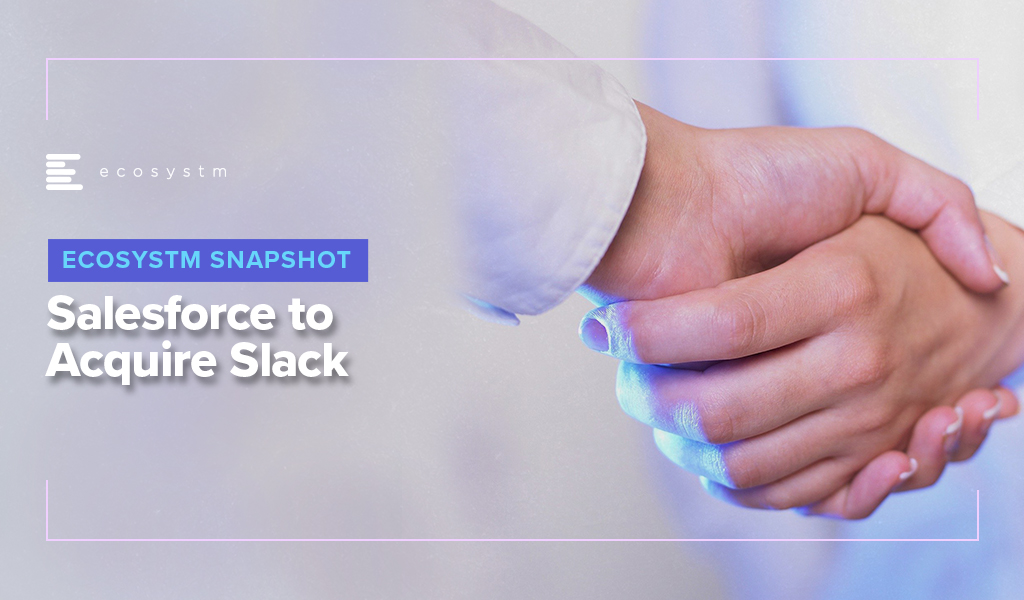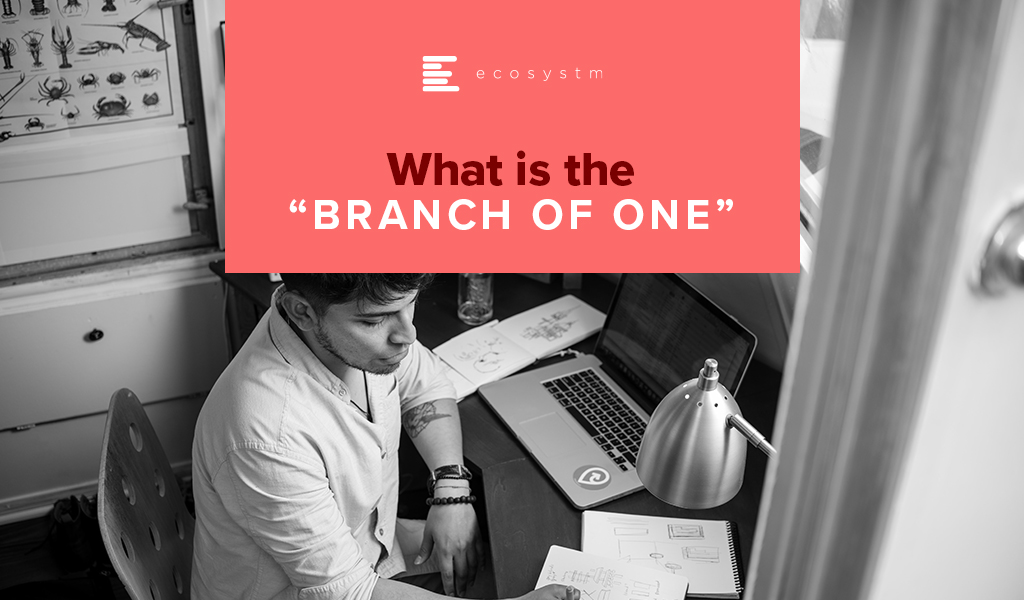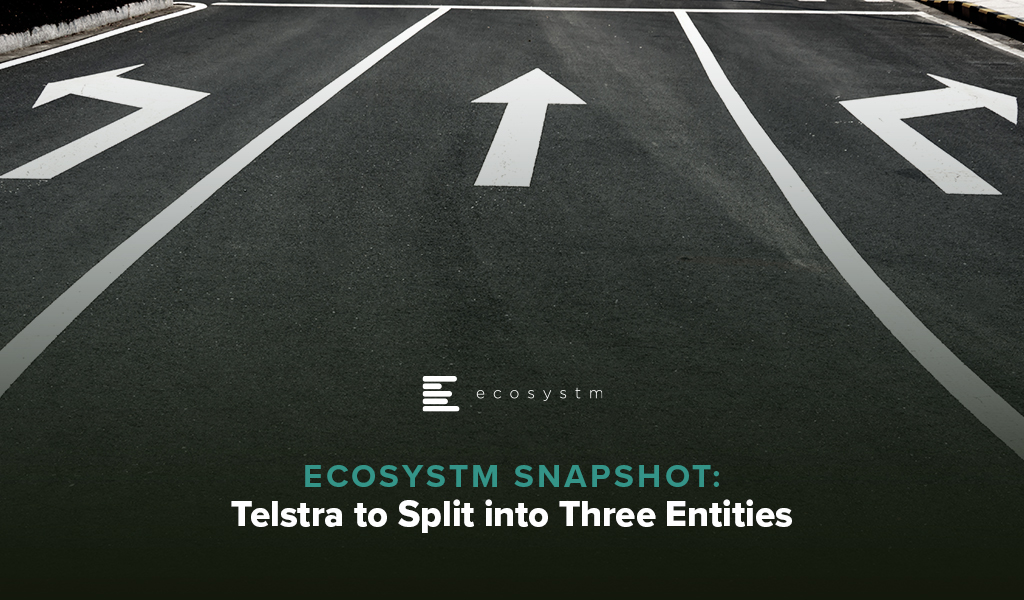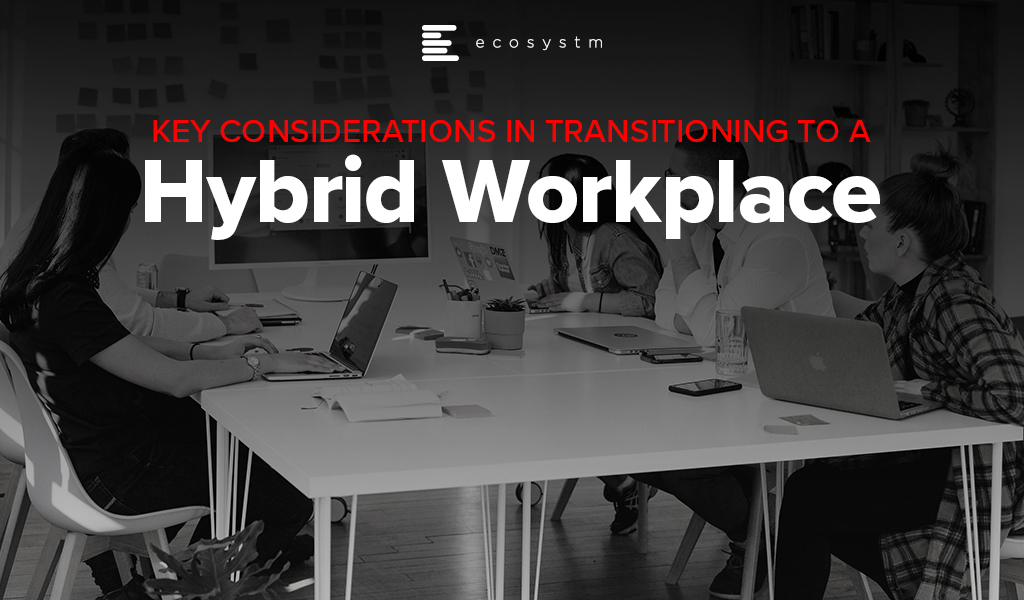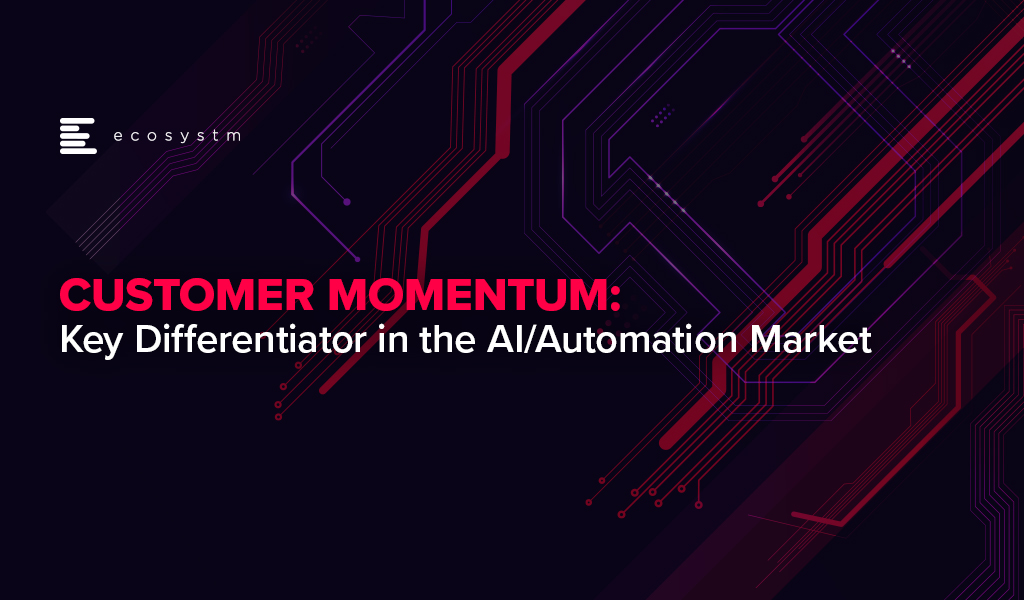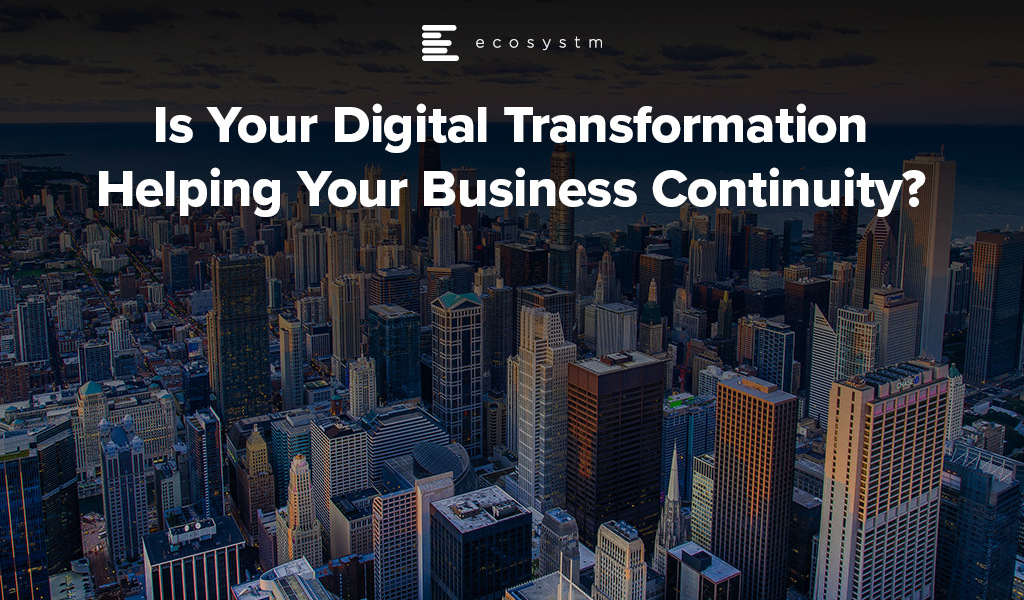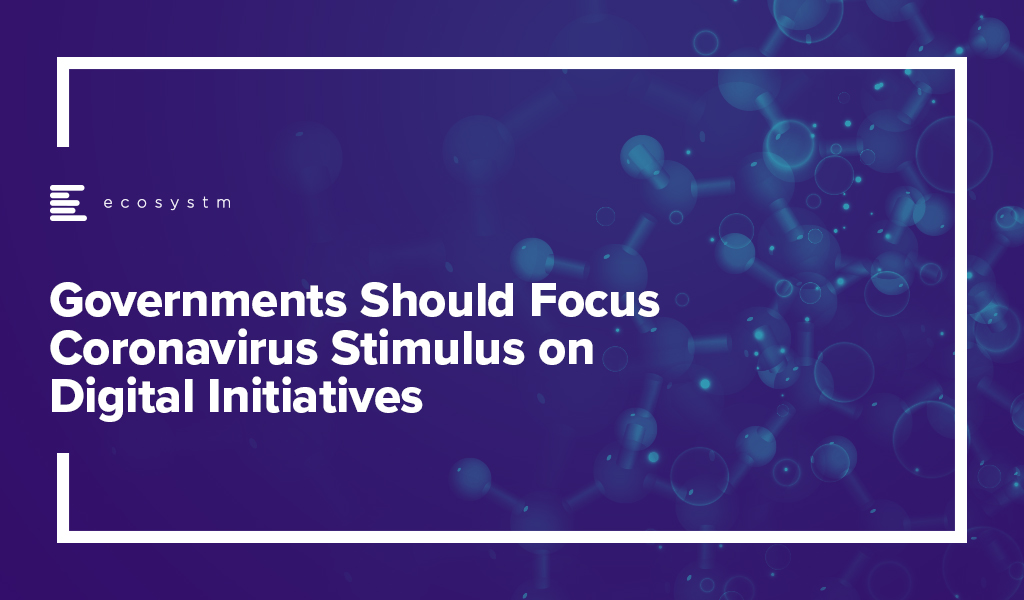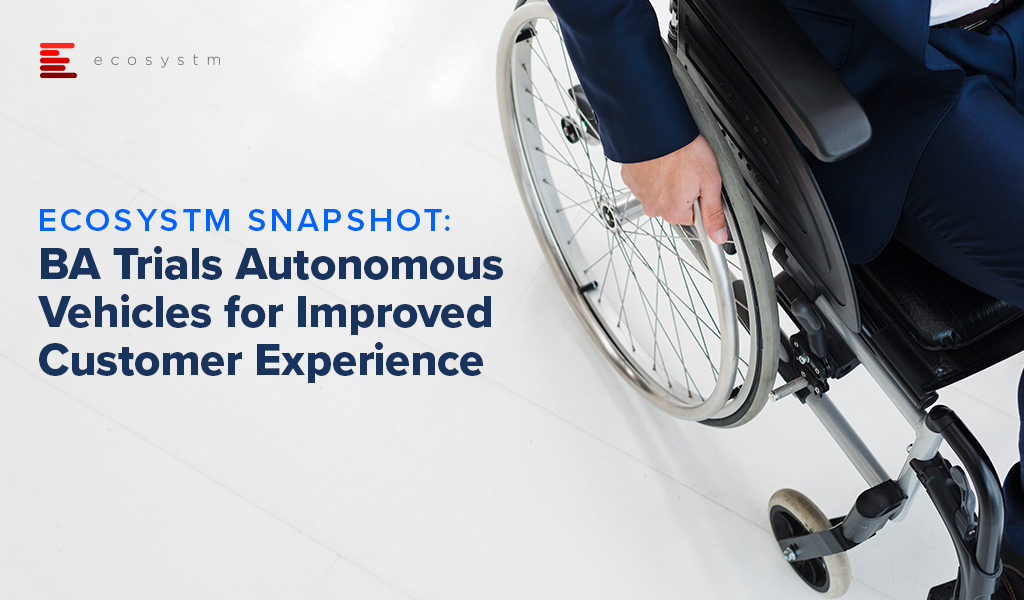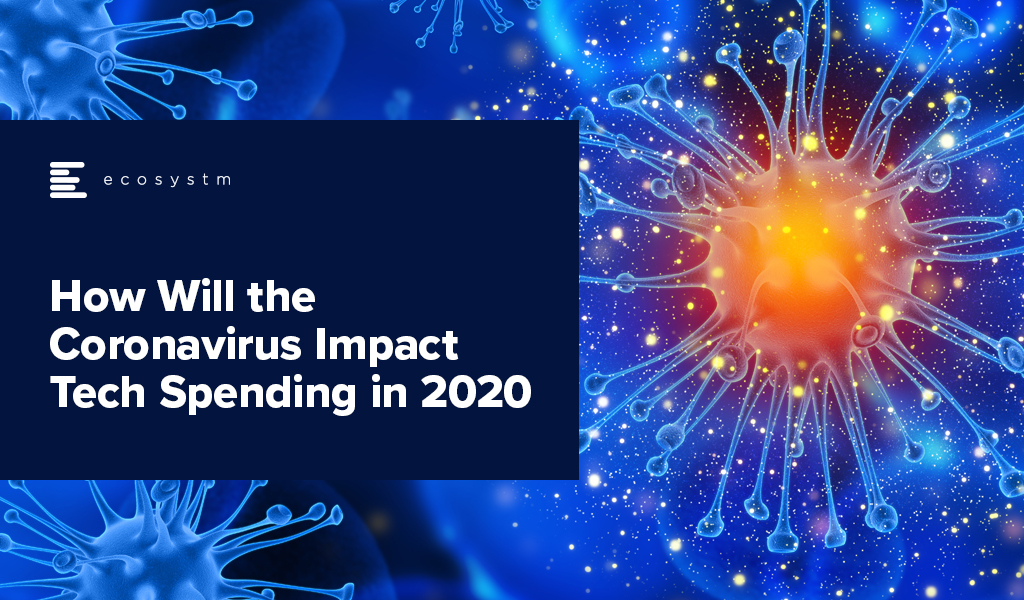Last week Salesforce announced that they will acquire Slack in a deal worth approximately USD 27.7 billion in their biggest purchase ever. Salesforce aims to ease the communication and collaboration process for information workflow across business apps and systems by integrating Slack into Salesforce cloud – Slack is set to be the new interface for Salesforce Customer 360. The deal is expected to complete in 2021, after shareholder and regulatory approvals.
Slack has carved a market presence as an all-in-one platform for voice, video, and collaboration. The acquisition of Slack will help Salesforce provide a more comprehensive services offering in a fast-growing SaaS business market.
Salesforce Continues to Broaden Horizon
Salesforce has been diversifying their offerings steadily over the last few years. Salesforce launched Chatter, the industry’s first cloud-based enterprise social collaboration application platform in 2010 globally; acquired cloud based word processing application Quip in 2016 for about USD $750 million; acquired Mulesoft in 2018, to unlock an entry into hybrid deployments and on-premises software. In 2019, Salesforce acquired Tableau – a leader in data visualisation for nearly USD 15.7 billion purchase and recently announced Salesforce Anywhere as innovation across Customer 360 to enable remote working.
With the acquisition of Slack, Salesforce is making a move to further develop their presence in the enterprise space – an area where Microsoft has an advantage with their Microsoft Teams and a suite of enterprise solutions.
Ecosystm Comments
The challenges to make the Slack acquisition valuable for Salesforce are many and difficult (and the significant hit to their share price reflects the market perception of these challenges). Many believe that Salesforce will be able to better compete with Microsoft due to the larger enterprise base and the larger enterprise salesforce. But that didn’t help Google accelerate into the cloud collaboration space. They sell advertising into many millions of enterprises across the globe – but selling advertising and selling collaboration platforms takes a very different capability to a very different audience. Salesforce sometimes prides itself on the fact that their buyers are NOT from IT – they are the heads of sales, marketing, customer experience etc. Attend any Salesforce event and you understand that only a small fraction of their audience are technology professionals. But these technology professionals are the ones who buy communications and collaboration tools and suites. They were the ones who turned to Microsoft Teams en-masse towards the beginning of the pandemic.
Possibly the biggest opportunity for Salesforce is to make Slack the default application interface for their applications and processes. One of the Salesforce’s ongoing challenges is the fact that – despite how easy to use or attractive their interface is – many users don’t want to use it! Salespeople want to sell; marketing people want to drive market outcomes. Salesforce supports these processes – but it can also get in the way (when not designed effectively). Slack gives Salesforce (and other application companies) a standard interface to provide the information employees and customers want or need in context. For example, instead of an email to HR asking for leave balance – or even needing to login to the time management systems – a user could ask a Salesforce (or other application) chatbot how much leave they have remaining for the year; a salesperson could ask what their best opportunities are. And in a chat or a collaboration session, Salesforce could feed data or insights directly into the conversation or alongside it.
Application switching is still one of the biggest killers of productivity. The era of the “zero-interface” application is quickly approaching – and the Slack acquisition gives Salesforce the ability to accelerate its move to this era. It also gives Salesforce the ability to extend the use of its core platform beyond the traditional users to the broader workforce.
Download Ecosystm Predicts: The Top 5 Cloud Trends for 2021
The full findings and implications of The Top 5 Cloud Trends for 2021 are available for download from the Ecosystm platform. Signup for Free to download the report.

Ecosystm recently partnered with Asavie to conduct a study into the opportunity and outlook for the “Branch of One”. One of the challenges was actually defining what the Branch of One is. Here’s what we came up with:
Branch of One enables Office Anywhere by delivering secure, frictionless access to all business resources, with full mobility – meeting the security and manageability requirements of CIOs and CISOs.
Basically it is all the data and systems you need to get your job done, in your pocket. Secure. Easy to manage.
What I really like about the idea is that it describes what business is trying to achieve and it gives a common language and outcome for IT and business leaders. Consider all the things that IT and security teams need to do to enable access to applications and data in remote branches – from connectivity to security to data and system access. Often it takes days, weeks or months to open a new office or branch, or to provision a new retail store. Now, imagine having the ability to roll out all of these systems and services in seconds. To a single user or to thousands. Without consideration for location. Business leaders will understand this benefits and will support it.
It also has the opportunity to help nearly every business today. Of the 1005 businesses we interviewed across the globe in our Global CxO Study 2020, 44% admitted to suffering cyber-attack incidents during COVID-19 due to employees working from home – and over half of these attacks were on mobile devices. Compromised devices were the number one target for cyber-attacks in 2020.
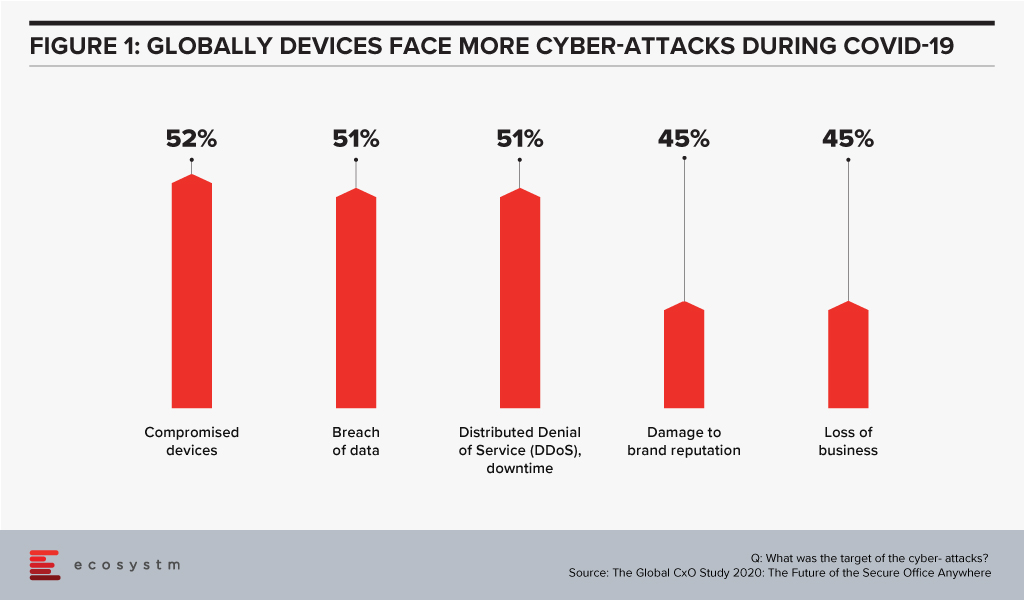
Businesses need a new way to manage the devices and applications of their remote employees. They need to be able to extend the benefits of the WAN to them without the downsides of VPNs. Every business we interviewed saw benefits of bringing devices, locations and offices inside the WAN. Turning every device and office into a Branch of One.
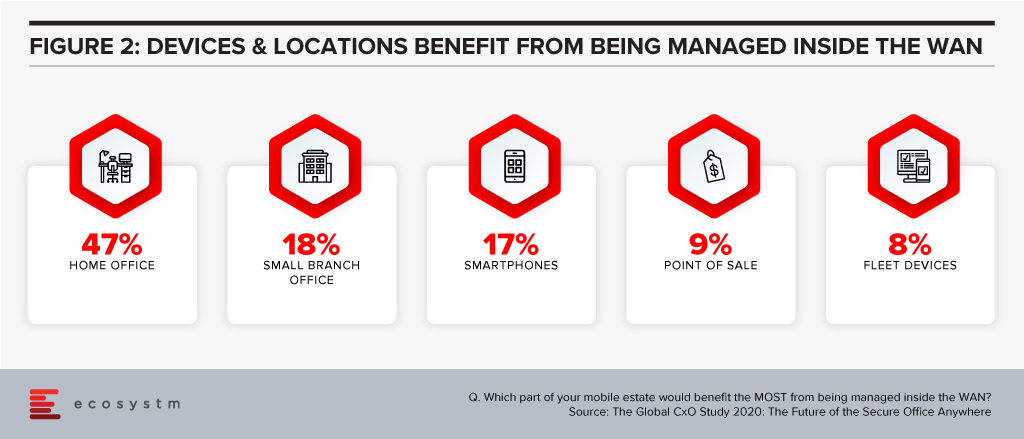
A few security and network technologies have promised this capability – SDNs can offer a similar service, but they require client software to be installed. 78% of businesses we interviewed are using VPNs to bring devices inside the WAN – but again, they require client software, and can be inconsistent (and insecure!) on mobile devices.
Companies that embrace the Branch of One can provision new users in a few clicks. No software to install, no cables to connect, no hardware to provision – it makes life easier for technology and security professionals. The Branch of One gives your employees the systems and data they need to get their job done – delivered securely across the mobile network.
Download the report based on ‘The Global CxO Study 2020: The Future of the Secure Office Anywhere’, conducted by Ecosystm on behalf of Asavie. The report presents the key findings of the study and analyses the market perceptions of Office Anywhere and the need for a ‘Branch of One’, which will be the foundation of enterprise mobile security in the future.

Telstra, Australia’s leading telecom provider has revealed its plans to split into 3 different units which would operate under the umbrella of the Telstra Group. The restructuring – scheduled to be completed by 2021 – is said to be the telecom giant’s biggest restructuring since 1997. The primary reason behind the move appears to be to spin off its infrastructure assets to realise their full value as competition intensifies.
In 2018, the Telstra2022 plan defined a four-pillar strategy to improve business, network superiority, cost improvements and respond to market dynamics for the next three years including the establishment of InfraCo and Global Business Services. Telstra established its standalone infrastructure unit, Telstra InfraCo to hold its fixed network assets. As a part of its recent announcement, Telstra’s infrastructure business InfraCo will split into two units – InfraCo Fixed which will run and manage Telstra’s physical infrastructure assets including data centres, ducts, fibres, undersea cables, and exchanges; and InfraCo Towers which will own and operate Telstra’s mobile towers and infrastructure. Meanwhile, the third unit ServeCo will focus on products and services for the consumer and retail businesses. The company is also investigating ways to push into renewable energy, with plans to exploit its renewable energy investments to re-sell cheaper energy to its customers.
This restructure, should it go ahead as described, is likely to be the biggest legacy that the current CEO, Andy Penn, leaves on the business. Recent CEOs have left a significant legacy on Telstra. Sol Trujillo – who admittedly had a rocky relationship with the Australian Government, which culminated in the conception of the National Broadband Network (NBN) – drove significant changes in Telstra; rationalising mobile and fixed network investments, driving focus back into the business and building an economically rational business. David Thodey was the great peacemaker, driving pride back into the Telstra staff and customers; he turned Telstra into one of the most customer-centric businesses in Australia in his time, laying the foundation for its ongoing success. Andy Penn has made some significant changes to Telstra, further reducing the cost base to turn it into a more competitive business – but until now, he has not significantly transformed the core business.
This changes now. Telstra ServeCo will build on the customer-obsessed culture of the Telstra sales and service business – one that consistently scores above market average for NPS in both the business/enterprise and the consumer markets. One can even envision a day in the future where ServeCo will be in a position to sell the best network solutions and services in Australia – some of which might not even be owned or controlled by InfraCo. It already does that with the NBN – this may extend to reselling other telecom services too.
InfraCo Fixed will build on the strong engineering legacy that Telstra still has – and will give it the chance to flourish – and not be dictated by customer buying cycles. Ideally investment cycles can be separated from direct customer revenue, and the company can rebuild the network lead that it has traditionally experienced, but which has been eroded over the past 3-4 years (in mobile by Optus and in fixed telecoms by NBN).
InfraCo Towers should be well-positioned to become the core tower provider in Australia. This business makes the most sense to spin off in the medium term. The buildout of multiple – nearly identical – tower networks by the three major 4/5G providers is wasteful and inefficient. 5G in particular, requires a very different tower footprint than 3G or 4G – so having a single provider of shared tower infrastructure will reduce costs for all telecom providers while creating a healthy business for shareholders. As an independent provider of towers, InfraCo Towers should always be the most affordable option – Optus, Telstra and Vodafone would be foolish to attempt to replicate and manage their own similar tower infrastructure.
The NBN-Telstra Dynamics
While Telstra dominates the Australian telecommunications market, their business is also under pressure due to the state-owned NBN. In 2019, Communications Minister Paul Fletcher ruled out selling the NBN to Telstra. However, the new structure has likely been designed with this in mind – with perhaps the option to spin off the InfraCo Fixed unit and merge this with a privatised NBN or perhaps to even the separation of the business units enough to satisfy a future government of the merits of selling NBN to Telstra and merging it with the InfraCo Fixed unit. The question surely needs to be asked what the difference is between a private business with a monopoly on home broadband access and Telstra having that monopoly?
This restructure will help Telstra build a telco for the next ten years. One where agility will be core to its success. The challenge – like with any big transformation – will be to take the employees and the customers on that journey. Employees need to believe that this structure is the right one and that their skills are required and relevant. Customers need to see benefits from this restructure too – ideally, they will see that the service promise of Telstra is delivered in the network and capabilities. Hopefully, they will see a stronger Telstra that can continue to drive the levels of innovation and investment that digitally savvy customers demand.

The past 3-4 months have seen technology leaders move mountains to support their newly remote employees and 100% digital customers. Over 40% of businesses in the Asia Pacific didn’t formally support remote working – so these companies have made massive changes in support of their employees. You have rolled out new hardware, new data protection and compliance policies, new security measures, collaboration software and VPNs. You have also strengthened the IT Helpdesk to better support remote employees and digital customer processes. And you are embracing the public cloud to offer new services and capabilities to customers and staff. The pace of change has been breathtaking – and things are not slowing down.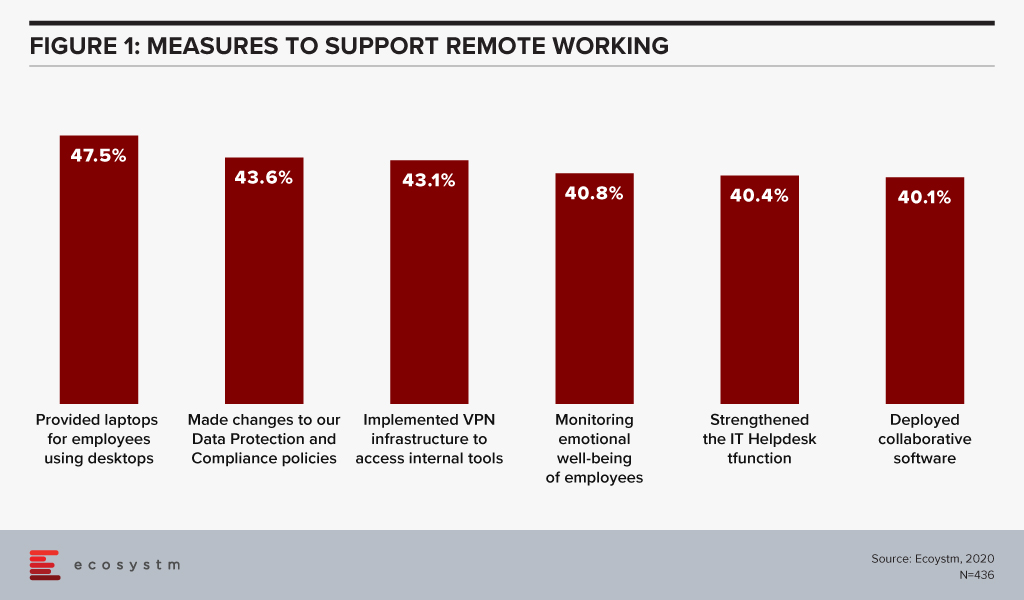
Many countries or economies are now moving to a hybrid working arrangement. This ISN’T about “going back to the way things were”. Hybrid working is really an important step on the road to the Digital Workplace – which enables access to the tools, data and processes that employees need to get their job done regardless of location or device.
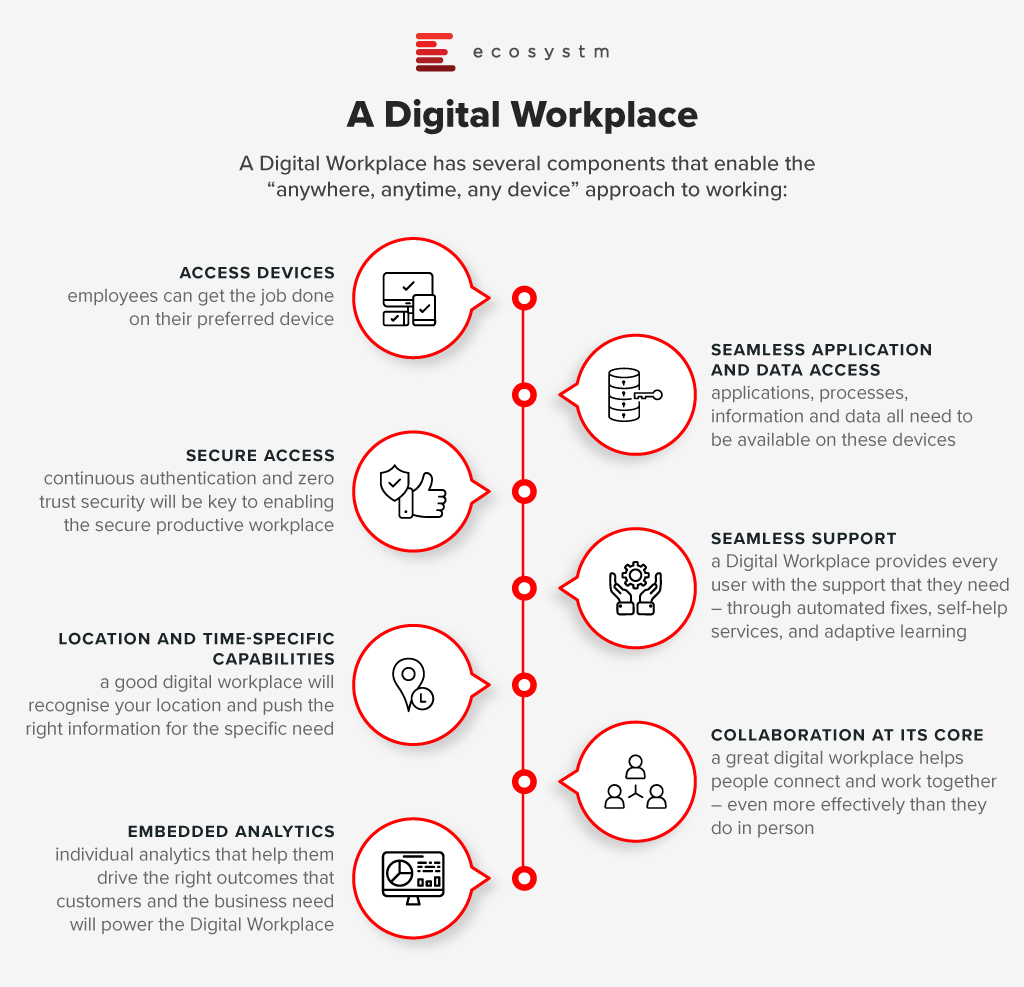
Many businesses claim that productivity has improved now that employees are working from home – some have even measured it and can prove it. We have to ensure that the move back to the office doesn’t negatively impact productivity. To drive continued productivity with hybrid working arrangements, consider:
- How will video calls work with employees in the office and at home? If employees in the office are docking their laptops, they immediately lose access to the camera. If they have monitors on their desk, they might not even be able to work with the laptop open. If they are in an open-plan office, the regular video calls might be distracting.
- What is the role of meeting rooms in the hybrid workplace? With social distancing an expectation in many countries today, the role of meeting rooms has changed. They will cater for fewer employees, and there is a growing need for them to be video-enabled.
- How do you manage hybrid meetings – where maybe 3-5 employees are on a single camera? How do you ensure every voice has equal weight – and that the right employees have their fair share of voice on the calls.
- How do you support employees who are moving between locations? You must focus on self-help services and automating as much of your Service Desk capabilities as possible.
- How can IT support social distancing in the office? Many companies are scaling back their hot desk environments to ensure there are fewer shared working environments.
- How will the changing location of employees impact business processes? Many of your processes were designed assuming employees were on site. You then redesigned many of them to assume they were not. Do you need to rethink them again?
- Does the application strategy work for all employees? There has been an increase in employees accessing applications from mobile devices – sometimes that was because it was a better experience, but too often it was because it was the only option. Is it time to rethink access and interfaces to make them relevant for all users?
- How do you keep employees and their data secure? Employees might move between secure and unsecured networks, work and home devices, on-premise and cloud applications. How do you keep them secure, backed up and synchronised – regardless of their device or location?
The move to hybrid working might not be a smooth one. The last thing you want to deliver is a poorer experience at one location versus the other, so you have work ahead in keeping your employees productive and secure – and hopefully, you’ll also move further down the path towards a Digital Workplace that can enable and empower all of your employees.

I’m really excited to launch our AI and Automation VendorScope! This new tool can help technology buyers understand which vendors are offering an exceptional customer experience, which ones have momentum and which are executing and delivering on their promised capabilities. The positioning of vendors in Ecosystm VendorScopes is independent of analyst bias or opinion or vendor influence – customers directly rate their suppliers in our ongoing market benchmarks and assessments.
The Evolution of the AI Market
The AI market has evolved significantly over the past few years. It has gone from a niche, poorly understood technology, to a mainstream one. Projects have moved from large, complex, moonshot-style “change the world” initiatives to small, focused capabilities that look to deliver value quickly. And they have moved from primarily internally focused projects to delivering value to customers and partners. Even the current pandemic is changing the lens of AI projects as 38% of the companies we benchmarked in Asia Pacific in the Ecosystm Business Pulse Study, are recalibrating their AI models for the significant change in trading conditions and customer circumstances.
Automation has changed too – from a heavily fragmented market with many specific – and often very simple tools – to comprehensive suites of automation capabilities. We are also beginning to see the use of machine learning within the automation platforms as this market matures and chases after the bigger automation opportunities where processes are not only simplified but removed through intelligent automation.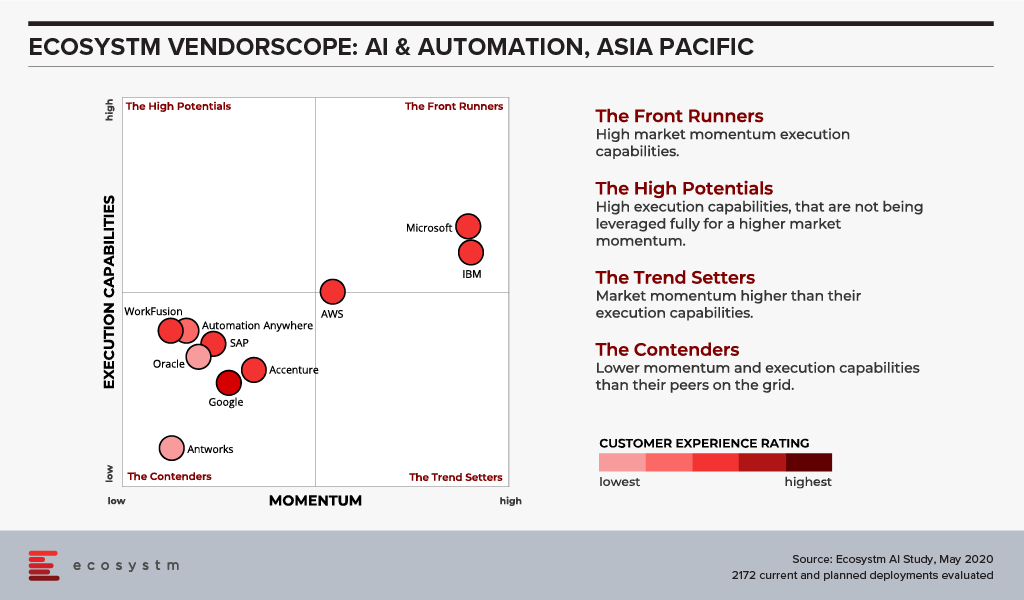
Cloud Platform Providers Continue to Lead
But what has changed little over the years is the dominance of the big cloud providers as the AI leaders. Azure, IBM and AWS continue to dominate customer mentions and intentions. And it is in customer mentions that the frontrunners in the VendorScope – Microsoft and IBM – set themselves apart. Not only are they important players today – but existing customers AND non-customers plan to use their services over the next 12-24 months. This gives them the market momentum over the other players. Even AWS and Google – the other two public cloud giants – who also have strong AI offerings – didn’t see the same proportions of customers and prospects planning to use their AI platforms and tools.
While Microsoft and IBM may have stolen the lead for now, they cannot expect the challengers to sit still. In the last few weeks alone we have seen several major launches of AI capabilities from some providers. And the Automation vendors are looking to new products and partnerships to take them forward.
Without the market momentum, Microsoft and IBM would still stand above the rest of the pack – just not as dramatically! Both companies are not just offering the AI building blocks, but also offer smart applications and services – this is possibly what sets them apart in an era where more and more customers want their applications to be smart out-of-the-box (or out-of-the-cloud). The appetite for long, expensive AI projects is waning – fast time to value will win deals today.
The biggest change in AI over the next few years will hopefully be more buyers demanding that their applications are smart out-of-the-box/cloud. AI and Automation shouldn’t be expensive add-ons – they should form the core of smart applications – applications that work for the business and for the customer. Applications that will deliver the next generation of employee and customer experiences.
Ecosystm Vendorscope: AI & Automation
Signup for Free to access the Ecosystm Vendorscope: AI & Automation report.

The current state of the world is alarming. The COVID-19 virus is not only disrupting businesses and economies – it is taking away loved ones, it is separating friends and families, it is disrupting the education of young adults and children and it is seeding fear in communities. But while the media is dominated with doom and gloom at the moment – and we do need these reports – I believe it is worth stopping for a moment to consider the fact that if the pandemic happened ten or fifteen years ago, many businesses – and government agencies – would have closed down. You could argue that the world wasn’t as globally connected then as it is now. And to an extent that is correct – the numbers of air travellers increased up until the end of 2019. But even in 2005, the world was still a very global place – economies relied on cross-border commerce as much then as they do now.
Depending on your business or industry 10-15 years ago:
- Staff couldn’t have effectively worked from home. And if they did, collaboration would have been hard (if not impossible outside of the usual voice services). Teleconference services would have needed to be booked.
- Remote access would have been painful and slow – relying heavily on VPNs over slower internet connections.
- Software would have mainly been running in company datacentres – with very little SaaS-based applications. These applications were often designed for LAN access…
- Those lucky few with a Blackberry or iPhone might have had access to email – everyone else would have needed to go into the office to get work done.
But worse than this would have been our customer engagements. While eCommerce had healthy adoption by 2005, it often relied on very manual processes – and it was mainly focused on consumer products and services – B2B adoption was still a number of years away. And, for many businesses, it represented a tiny proportion of their revenue. Small companies didn’t often have the web presence to compete with the big players. But if I look at the big fast-food giants in Australia (e.g. McDonalds and KFC) – these companies didn’t have a web or mobile ordering until a few years ago, and even more recently for home delivery services. Any company that had to shut down their face-to-face contact would have likely fallen back on their contact centres – but even these would have been impacted as the ability to route calls to remote or home-working call centre agents barely existed then – so they would have been understaffed or closed due to an infection being discovered…
Today’s digital connectivity has the opportunity to save lives. Less physical contact means less people being exposed to – and spreading – the virus.
If this pandemic had happened 10-15 years ago, many small AND large businesses would have had to shut their doors very quickly. Very early in the cycle, businesses would have had to make the decision to shut their doors straight away, or risk accelerating the infection rates by having staff continue to attend the office or contact centre. So if there is one small positive we can take away, it is that our digital investments are paying off very quickly. The ability to continue to trade, continue to sell, continue to do business in such a market as we are facing today and tomorrow is priceless. I can purchase goods and services online, register my car without leaving my desk, upgrade or change my health insurance without speaking to a single human being. Most businesses have the ability to have their employees access many of their critical applications wherever they are located. Our accountants can still pay and send bills, HR can hire for open positions, product teams can continue to innovate on the products and services they offer.
Don’t get me wrong – business survival is not guaranteed. This is why I implored governments to aim their stimulus spending towards small and medium businesses digital initiatives – as cafes, retailers, bars and restaurants close down across cities, states and countries, many are now lamenting their immature online presence, their lack of delivery and their lack of pre-ordering. If you have any doubt about this, check your local Facebook group – it is full of small businesses putting up images of menus in the hope that customers will reach out directly to keep their businesses running. If these businesses are given incentives to build digital services quickly, they might see less of a slowdown in business.
COVID-19 will definitely stress test our digital assets and strategies. Just recently, the Australian government’s citizen-facing portal crashed as too many citizens logged on to register for welfare. This forced many people out into government shop-fronts – putting themselves, the staff and all connected families and friends at risk of catching the virus. I also heard today of a bank that called many of its staff back to the office as the VPN could not cope with the number of users and volume of traffic! If you have not already, you will quickly find out how your digital capabilities are performing – where you need extra capacity, where services are running smoothly, where you need to rethink process design or where you need to consider re-crafting this approach for the fully digital era.
But stay safe – listen to the advice of medical experts and act on that advice. A senior medical officer recently stated that social distancing is the only way that we will overcome this virus – so stay safe and stay home (if you can!). But also take the time to review your digital capabilities – start making moves now to ensure they help your business stay afloat – or your government agency to keep serving citizens in times of restricted trading or shutdowns.
The last week or so has seen a numbers of central banks (such as the US and Australia) ease their monetary policies – lowering interest rates in order to stimulate investment and economic activity. But this alone won’t be enough to slow down economic growth – the generally accepted wisdom is that governments will need to quickly roll out stimulus packages to get money into the economy faster. Some countries, like Hong Kong, have already kicked off this process – others are likely be announce packages over the next few weeks.
Typically, these stimulus packages are designed to get the economy moving again – bringing forward existing spending plans or creating new spend. Good stimulus packages will have a broad impact but also drive improved business and employment outcomes. Some are targeted towards the sectors most impacted (e.g. in Australia the seafood export market has been impacted heavily by China’s decision to stop importing any seafood; in Thailand the tourism sector is hit hard by the slowdown in arrivals from China – that makes up a large percentage of the tourists in an economy where tourism is a significant sector).
But often they are not targeted. Some governments might just let businesses write off any investment faster than usual (such as within a single financial year instead of depreciating the spend over a number of years) or will just send a cheque to every income earner. The issue with these stimulus packages is that they don’t drive a specific outcome apart from getting spend into the economy faster. Stimulus packages have an opportunity to drive change – and the COVID-19 virus has shown that some businesses are not well equipped for the digital era. They are finding it hard managing the distributed workforce when they ask their staff to work at home. There are also many challenges that governments and businesses are facing in serving customers across digital channels.
This is the opportunity for governments to stimulate the economy and help businesses improve the digital experiences of customers and employees. The world is going digital – we all know what good digital experiences look like as we have them on our smartphones in our pockets. But we also know that most companies and government agencies we deal with are not offering great digital experiences… And while we all hope that virus outbreaks such as COVID-19 don’t happen that often, we know that something like this will happen again – so it would be great if businesses were prepared for such an outcome.
Therefore now is the chance to target the stimulus packages towards both the impacted sectors of the economy as well as the areas of spend that will drive better digital experiences for customers and employees. There could be incentives to spend more on software and cloud services, spend more with consultancies or spend more with digital marketing agencies. It will also help small businesses compete with larger businesses on an equal playing field (for example, the large takeaway food outlets have an app that lets you pre-order food, but many small ones do not).
In 2009, the Australian government rolled out a stimulus package – one that was ultimately one of the major reasons the economy came through the global financial crisis without falling into recession. They gave an immediate cash stimulus to taxpayers which helped get an immediate spend in the economy. They also had a housing insulation spend which promised roof insulation for 2.7 million homes – this provided stimulus to the economy in the mid-term. They then provided new school halls, social housing and roads – which provided the stimulus in the longer term. While it can be argued that the programs were not effectively administered, the stimulus got the economy moving and also helped the government hit some longer term goals – such as reducing greenhouse gas emissions (through better housing insulation therefore less use of electricity to heat and cool homes) and also upgrading aging infrastructure in schools across the country. For many businesses, the focus today is on providing great customer experiences – and many of those experiences will be digital. Governments have the chance to use their stimulus p to accelerate that outcome.

There have been several pilots and implementations of autonomous vehicles, mostly with the focus on asset management and supply chain efficiency. However, the recent trial by British Airways (BA) at the JFK airport is a good example of autonomous vehicles being used to improve customer experience. The trial involved using fully autonomous, electric mobility devices to assist their passengers with mobility challenges. These vehicles are equipped with anti-collision measures as well as map functions to take the passengers to their preferred destinations.
Businesses across all industries and sectors are looking to improve their customer experience. These initiatives are primarily meant to drive return business – but when done well, they can also drive down costs and drive up brand perception. This initiative from BA is a great example of a company looking to put the customer at the centre of their business and solve customer pain points – particularly one as sensitive as providing equal access to services regardless of physical ability.
Serving customers with mobility challenges is a minefield for airlines – it is difficult to know exactly when people with mobility challenges will arrive at the airport and need to check in – and in a low margin business like the airlines industry, you cannot afford to have staff deployed just to assist passengers to the right gate or location. Even keep track of the location of the mobility assets – such as wheelchairs – at any given time can be challenging. Taking a staff member off check-ins or baggage handling to transport the customer with mobility challenges to their gate can impact the experience of other customers too. Often it can turn out to be lose-lose outcome, despite the best intentions.
And the BIG risk is when you get it wrong, there is a high likelihood that you will be crucified on social media – you can be certain of many retweets and angry emojis of inconvenienced passengers missing flights, left stranded at gates or stuck in security. So even if you tried to do a good job, it has the potential to backfire.
BA has thought out of the box here with this solution, starting with the challenge of getting people with mobility issues to their flights on time. But the added benefit they will likely see is the ability to do this quickly. These wheelchairs being autonomous and equipped with map functions should be easier to track and requisition just-in-time. This means customers will have to wait less for their wheelchairs and also be less concerned they might miss their flights – it may even mean that mobility challenges customers can even have the same airport experience as other customers – without the need to allow extra time to arrive at the gate. These vehicles free staff to serve all customers without having to divert attention to the one passenger whose needs are greater. This is also likely to get a lot of good PR and social media activity – helping the brand and showing their willingness to invest to ensure equal access to services regardless of ability. I know if I saw such a device in an airport I would ask the person in the chair if I could snap their picture to put it on social media – and credit BA for being an inclusive airline. While they cannot control bad social media coverage – BA has thought of a service than can help strengthen their brand. And again – at the centre of this is a happy customer.
By focusing on solving a real customer problem, BA should be able to win more business from those with mobility issues – a market which is growing rapidly – and also strengthen their position as an inclusive air travel provider.
2020 was originally forecast as a good year for technology spend. Many categories took a hit in 2019 – hardware, telecommunications, datacentres – even the software and IT services segments came down from their high growth rates of previous years. The consensus for growth in IT spend in 2020 was somewhere between 3-4%. But that growth is now under threat by the COVID-19 virus that is spreading across the globe. The 26th February was a significant day, as the number of new infections outside of China is now greater than those in China. Furthermore, the growth in infections is not isolated. Iran, Italy and South Korea all have experienced significant growth and the virus has hit Brazil, directly from Italy.
With the situation changing every day it is hard to have a firm view on how it will impact broader economic growth as well as the technology spending. Much will depend on the ability of countries to control the spread of the virus along with the fiscal stimulus packages of governments across the globe. Some countries are in a better position than others to push money into economies to keep them growing.
But even with the uncertainty, it is worth noting some feedback we are getting from tech buyers, vendors and economists. While much of this feedback is anecdotal, we believe it is indicative of trends across the market. The next few weeks are critical. If China shows that they can stop the transmission of the virus, that will help global confidence which has been hurt by the newer outbreaks in Italy, Iran and Korea.
Overall Economic Spend is Slowing
Businesses across the globe – particularly those in heavily impacted economies (such as China, Italy, Japan & South Korea) and those impacted by the slowdown in China (Thailand, Australia etc) – are putting the brakes on spending across the board. And there are not too many initiatives in businesses today that don’t involve technology. We are seeing projects delayed and – more rarely – cancelled. Several central banks, such as those in Thailand and Singapore, have lowered their growth forecasts, as has the IMF and OECD. Ratings agencies and economists have also reduced their growth forecasts for heavily impacted economies. The USA is avoiding much of the slowdown although the Nasdaq High Tech Index was down around 8-9% on the 28th February – the market has priced potential future slowdown into share prices already.
Limited Face-to-Face Collaboration Will Slow Tech Spending
We are also seeing the projects that are underway slowing down: more staff are required to work from home; experts can’t fly in to help drive projects; and without teams meeting physically, collaboration has become harder than ever before.
This doesn’t mean the projects aren’t happening – the timelines are slipping. Will this impact the overall spending in 2020? Yes! But not by much at all, as many projects these days are delivered in 3-6 months – not 24 months like years gone by. So, delivery will mostly happen in 2020, but more in the second half than the first half. But again, with the situation changing every day, the scenario might change. As soon as growth in the number of infections slows down and the travel bans are lifted, we can expect activity to slowly return. But the further out that is, the more projects will decrease scope, be cancelled or be shelved for another day.
Another factor impacting innovation and the resulting technology projects is the lack of face-to-face collaboration between management teams. Some businesses have already put into place initiatives to ensure their board and executive management do not meet face-to-face. This is because they are considered the most valuable assets to the business – and are often likely to be in the age group most heavily impacted by the coronavirus (over 50). While not suggesting that collaboration cannot happen in virtual environments, it is sometimes a shared experience or non-business interaction that might drive a new idea for the business. And that idea might end up driving tens of millions of dollars of technology spending.
Cash Flow is Impacted – Which Slows Business Investment
Cash flow is already being impacted. Small and medium enterprises (SMEs) are already feeling the pinch, and they don’t have access to the funding tools that many large businesses use to get through tough times. SMEs really represent the biggest threat to spending: if a large business has to lay off some staff, they can then get a project going as soon as the economy or their sector recovers and employ the people they need, as required. But in countries like Australia and the US, small businesses represent almost 40-50% of economic activity. If SMEs shut down or even restrict spending, it takes some time for new businesses to start up and fill in the gap they leave. SMEs don’t tend to buy software or services from the large vendors – they tend to use small and medium services and software providers – so it is these smaller technology businesses that are immediately threatened if the coronavirus spread continues. The multiplier effect quickly comes into play here to reduce consumption, employment and economic activity.
We are also aware that some businesses that are directly impacted by the virus (such as those in the travel sector) have informed their suppliers that they won’t be paying any bills until mid-year. This could also put a small technology provider under – whereas a larger one should be able to survive the cash-flow crisis. Despite most economies having a low interest rate environment, the access to capital is not easy, particularly given the risk to the overall economy. A further challenge to global expenditure and an accelerated recovery is the US elections which provide distraction to businesses in the US and globally.
Cancellation of Customer Events Will Limit Technology-Led Innovation
Many vendors have cancelled or postponed their customer events, even in relatively unaffected markets such as Australia. And nearly every vendor will attest to the spike in opportunities and deals that get signed after these events. The coming together of potential and existing customers with thought leaders, tech evangelists, bleeding edge customers and the partner ecosystem drives new ideas. Individuals get inspired to act – they hear about best and next practice and kick off conversations within their businesses. They see how technologies can impact other businesses and use those assumptions within their own business cases. Sceptical customers become converts, and those already considering projects sometimes accelerate them.
With these events cancelled tech spending will not collapse. Companies still have budgets and these budgets will be, for the most part, spent. But it is the innovative initiatives that will suffer – the exploration of new technologies or services, the experimentation and testing that won’t happen because people simply won’t know about it. This is the spending that is typically not budgeted for – the new spend that often has a big impact on business results and customer outcomes. These customer events are learning opportunities – without the events the learning will be harder and slower to push out. So, this will likely have more of an impact on spending in calendar Q2-Q4. But without other assets in the market or other chances to educate clients and prospects, this spend simply won’t happen.
The COVID-19 virus is also impacting the technology supply chain. Many technology products are manufactured in China – or rely on components manufactured in China. Factories across China have been shut down – and while some are coming back online, it is hard to know how long it will take them to get back to full capacity. Transport services in China are impacted –globally 200,000 flights have been cancelled since the public emergence of the coronavirus. Some products are waiting but just cannot be shipped. A number of vendors have flagged the impact of the slowdown to the supply chain on their revenues, including Apple and Microsoft. With limited supply, prices are rising, which slows down demand. While this may show some short-term opportunity for the cloud providers, the hardware companies and the software providers that rely on the availability of hardware will feel the impact. In the longer term, it may lead to business reviewing their supply chain and risk analysis. This presents an opportunity for India, Vietnam and other potential manufacturing hubs.
The Overall Impact of the COVID-19 Will be Real and Measurable
Ultimately, we believe that the coronavirus will wipe up to 1.5% off the total tech spending for 2020 – bringing the overall average down to between 1.5% and 2.5%. Part of this is based on the fact that technology spending is coming off a poor year. Confidence was just starting to climb with some of the hardest hit segments expected to return to growth in 2020. This confidence will disappear – and could lead to further price competition. Which is good for the buyer but bad for the whole vendor supply chain!
But again, this depends on the response of central banks and the ability of countries to control the spread of the virus. The development of a vaccine would be ideal but appears to be highly unlikely. The sooner it is brought under control – along with effective targeting of fiscal stimulus packages – the lower the impact on overall economies and the technology spending of businesses.
Some sectors will witness growth – telecoms providers, collaboration software and tool providers, remote and online education providers, cloud providers and healthtech will all witness growth – in fact many are already! Digital spending will increase as face-to-face opportunities plummet – this will drive opportunities for advertisers, digital agencies and developers.
Now is the time to make contingencies – vendors need to get better at digital marketing and selling and simpler implementation. Tech buyers and implementers need to put in place best practices for remote working – many companies witness an increase in productivity when they get remote working right.
Please let us know your feedback or thoughts in the comments section – we look forward to keeping the analysis going – and stay healthy!
This post was authored by Tim Sheedy, with valuable assistance from Phil Hassey, Sash Mukherjee and Claus Mortensen.



